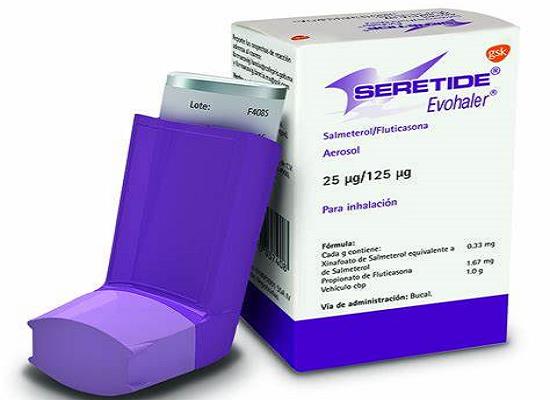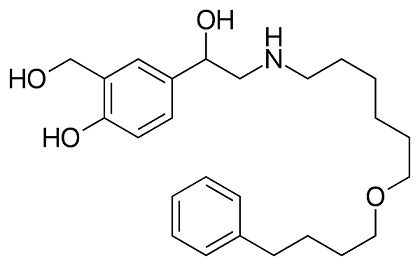Salmeterol: Mechanism of Persistence and Clinical Applications
General Description
Salmeterol, a long-acting β2-adrenoceptor agonist, is widely used for the treatment of respiratory conditions like asthma and chronic obstructive pulmonary disease. Its mechanism of persistence has been debated, with various theories proposed, including lipid solubility and receptor rebinding. Comparisons with other LABAs suggest that lipophilicity plays a role in its prolonged action. However, the involvement of exosite binding and other mechanisms, like those seen with indacaterol, remains uncertain. To gain a clearer understanding, future studies should focus on controlled experiments using isolated systems. Salmeterol's clinical applications include maintenance treatment for asthma and COPD, improving lung function, reducing symptoms, and enhancing quality of life. Combination therapy with corticosteroids is common. Overall, salmeterol provides long-lasting bronchodilation and symptom relief, benefiting patients with respiratory conditions.

Figure 1. Salmeterol
Mechanism of Persistence
Salmeterol, a long-acting β2-adrenoceptor agonist, exhibits a complex mechanism of persistence that has been a subject of debate for nearly two decades. Various proposed mechanisms, such as the plasmalemma diffusion microkinetic model and the exosite model, have been considered to explain salmeterol's duration of action. Additionally, a new suggestion of β2-adrenoceptor rebinding has been put forward as a potential contributing factor. The debate surrounding salmeterol's mechanism of persistence revolves around whether its lipid solubility alone is sufficient to explain its prolonged duration of action or if other factors, such as exosite binding, play a role. Studies comparing salmeterol with other LABAs, like formoterol, have highlighted the importance of lipophilicity in determining the duration of action. However, the validity of the exosite hypothesis and the role of receptor rebinding in explaining salmeterol's effects remain uncertain. Further complicating the issue is the introduction of indacaterol, an 'ultra-LABA' with a longer duration of action than salmeterol but different chemical characteristics. The unique properties of indacaterol suggest the involvement of additional mechanisms beyond traditional explanations based on lipophilicity or receptor interactions. To resolve the debate and gain a clearer understanding of salmeterol's mechanism of persistence, future studies should focus on carefully designed experiments using simple systems like isolated membranes or cells to minimize the confounding effects of tissue bulk. By conducting precise functional assessments in controlled experimental settings, researchers can elucidate the specific factors contributing to salmeterol's extended duration of action and potentially pave the way for the development of improved compounds in this class. 1
Clinical Applications
Salmeterol is a long-acting beta-agonist commonly used in the treatment of respiratory conditions such as asthma and chronic obstructive pulmonary disease. Its unique pharmacological properties make it a valuable medication in managing these conditions effectively. One of the key clinical applications of Salmeterol is its role in the maintenance treatment of asthma. It is typically prescribed as a controller medication to be used regularly to prevent asthma symptoms and exacerbations. By acting on beta-2 adrenergic receptors in the airways, Salmeterol helps to relax the smooth muscles, thereby dilating the bronchial passages and improving airflow. This mechanism of action allows for better control of asthma symptoms and reduction of the frequency and severity of asthma attacks. In addition to asthma, Salmeterol is also utilized in the management of chronic obstructive pulmonary disease. Patients with chronic obstructive pulmonary disease often experience airflow limitation and difficulty breathing due to bronchoconstriction and inflammation. Salmeterol's long-acting effects make it a suitable option for improving lung function and reducing symptoms in these individuals. By promoting bronchodilation over an extended period, Salmeterol can help patients breathe more easily and enhance their overall quality of life. Furthermore, Salmeterol is often prescribed in combination with corticosteroids, such as fluticasone, in a single inhaler device. This combination therapy addresses both the inflammatory component of respiratory conditions and the bronchoconstrictive aspect, providing comprehensive treatment for patients with moderate to severe asthma or chronic obstructive pulmonary disease. Overall, Salmeterol plays a crucial role in the management of asthma and chronic obstructive pulmonary disease by providing long-lasting bronchodilation and symptom relief. Its clinical applications extend to improving lung function, reducing exacerbations, and enhancing the quality of life for patients with these respiratory conditions. 2
Reference
1. Coleman RA. On the mechanism of the persistent action of salmeterol: what is the current position?. Br J Pharmacol. 2009;158(1):180-182.
2. Weinberger M. Salmeterol for the treatment of asthma. Ann Allergy Asthma Immunol. 1995;75(3):209-211.
);You may like
Related articles And Qustion
See also
Lastest Price from Salmeterol manufacturers

US $0.00/KG2024-03-16
- CAS:
- 89365-50-4
- Min. Order:
- 100g
- Purity:
- 98%+
- Supply Ability:
- 100kg

US $60.00/kg2024-02-27
- CAS:
- 89365-50-4
- Min. Order:
- 1kg
- Purity:
- 99%
- Supply Ability:
- 20 tons




